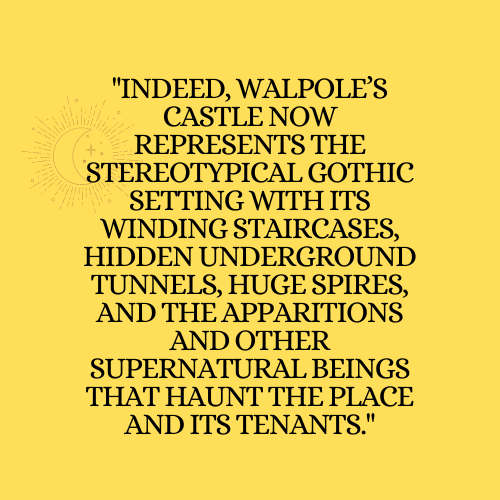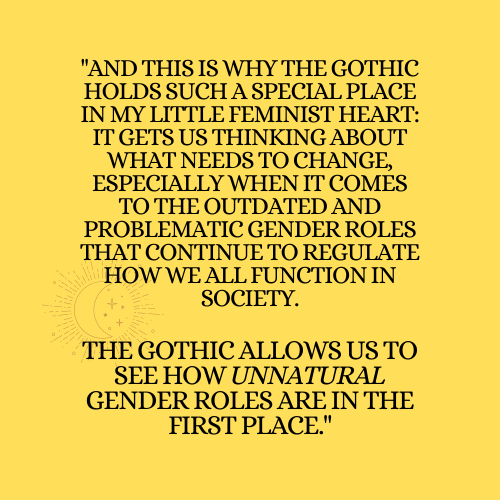My Little Feminist (and Gothic) Heart
I realize I’ve used this phrase a couple times on this blog already regarding activist Tarana Burke and some of Stephen King’s works but—what the hell—I’m going to use it again: the Gothic holds a very special place in my little feminist heart.
The Gothic is where I planted my feminist roots and the place from which I continue to grow as a feminist. I even wrote my graduate thesis from both feminist and Gothic perspectives, and I’m still heavily invested in Gothic literature today (currently reading Peter Straub’s Ghost Story, in case you’re looking for a spooky read).
I guess what I’m trying to say is that I have a lot of thoughts and opinions on feminism and the Gothic. I mean, my thesis is about sixty pages long and I could still blather on and on about it.
And I will. Right now.
What is “the Gothic”?
My apologies, I probably should have started with this (the Gothic just gets me excited, okay?): what even is “the Gothic”?
It may come as a disappointment to some of you, but—unfortunately—when I refer to the Gothic, I am not referring to those individuals who wear all black everything, try to avoid the sun (and suntans) at all costs, listen to death metal, and refer to themselves as “goths.” Though if you could tell me a bit about them, I’d be happy to listen. I kind of always wanted to be one but I have a year-round tan (blasted genetics!) and can’t stand death metal.

No, the Gothic—for me, anyway—will always refer to that period of time characterized by grandiose architecture, a general sense of melancholy in the air, and novels placed in spooky settings. These spooky settings usually—but not always—consist of some sort of abandoned or haunted house and a set of characters being haunted by whatever is in that abandoned or haunted house.
You can also throw in a thunderstorm and a black cat on an iron gate, why not?
It was Horace Walpole who basically created the framework for the entire Gothic genre with his groundbreaking novel, The Castle of Otranto (1764).
Indeed, Walpole’s castle now represents the stereotypical Gothic setting with its winding staircases, hidden underground tunnels, huge spires, and the apparitions and other supernatural beings that haunt the place and its tenants.
The Connection Between Feminism and the Gothic
You might now be wondering: how does a spooky old castle tie into feminism?
Although setting obviously plays a large part in a novel being classified as “Gothic”—the stereotypical haunted castle with the hidden passages—so, too, do the themes and plotlines of the narrative.
The Gothic tends to focus quite heavily on family relations (incest is weirdly common in the Gothic genre), fighting over some kind of estate or power (the domestic, or the home, is very big in the Gothic), and the breaking down and critiquing of stereotypical gender roles.
Walpole checks off all these boxes with The Castle of Otranto, which is to be expected since Walpole created the damn checklist.
The Castle of Otranto starts with an overtly patriarchal character, Manfred, attempting to marry his dead son’s fiancé, Isabella—there’s that incestual undertone already—so he can maintain ownership over the family estate, Otranto, and carry on the family line. Isabella ultimately refuses Manfred and there are suggestions laced throughout the novel that Manfred intends to become violent with Isabella if she does not comply with his desires.
This sounds incredibly problematic, doesn’t it? Manfred only wants to marry Isabella—and basically believes he has a right to marry her—so he can maintain power over both her and Otranto. To Manfred, Isabella is simply a damsel in distress who needs saving.
And the novel only becomes more problematic when you continue reading: Manfred finally ends up killing his own daughter, Matilda, because he mistakes her for Isabella. You can’t get much more patriarchal than killing your own daughter in the pursuit of property and power, can you?
Walpole’s novel sounds kind of awful at this point and you’re probably wondering how The Castle of Otranto—and the Gothic in general—could possibly fit into the feminist tradition.
And this is where the supernatural comes into play.
The Significance of the Supernatural in the Gothic
If The Castle of Otranto was just run-of-the-mill Realism—a literary genre that is typically classified as representing the everyday, somewhat mundane lives of individuals with no inclusion of the supernatural—then, yes, Walpole’s representations of gender could very well be seen as problematic and reinforcing stereotypical gender roles.
However, it is critical to note that Walpole cushions his novel with images of the supernatural. For instance, Manfred’s son, Conrad, is crushed and killed by a massive piece of armor right before he is supposed to marry Isabella. This is not natural, right? We would never experience this in our everyday lives. There are also apparitions consistently wandering and haunting the halls of Otranto. Again, not natural.

What these images of the unnatural—or the supernatural—do is get us thinking about what else might be considered unnatural and natural within the novel. Is it natural that Manfred wants to divorce his wife and marry a young woman just so he can carry on his family lineage and maintain power over his estate? Is it natural that Manfred resorts to murder at the end of the novel? Is it natural for women to be viewed only as damsels in distress who require saving?
No, none of these things are necessarily natural. We just live in a society that has already chosen what is natural and unnatural for us; a society that has chosen what is normal and abnormal.
And this is why the Gothic holds such a special place in my little feminist heart: it gets us thinking about what needs to change, especially when it comes to the outdated and problematic gender roles that continue to regulate how we all function in society.
The Gothic allows us to see how unnatural gender roles are in the first place.
Hairstyles
wonderful post, very informative. I wonder why the other specialists of this sector don’t notice this. You must proceed your writing. I am confident, you have a great readers’ base already!
Hairstyles
Hi there, I found your web site via Google while looking for a related topic, your site came up, it looks great. I’ve bookmarked it in my google bookmarks.
KAYSWELL
I truly appreciate this post. I have been looking everywhere for this! Thank goodness I found it on Bing. You have made my day! Thx again
Hairstyles
I抳e been exploring for a bit for any high quality articles or weblog posts on this kind of area . Exploring in Yahoo I finally stumbled upon this site. Reading this information So i抦 happy to express that I’ve an incredibly good uncanny feeling I found out exactly what I needed. I such a lot indubitably will make certain to don抰 omit this website and give it a glance regularly.
Beauty Fashion
Have you ever considered about adding a little bit more than just your articles? I mean, what you say is fundamental and everything. However think about if you added some great images or video clips to give your posts more, “pop”! Your content is excellent but with pics and clips, this site could definitely be one of the best in its field. Great blog!
Hairstyles
Normally I don’t read post on blogs, however I would like to say that this write-up very compelled me to check out and do it! Your writing taste has been surprised me. Thanks, quite great article.